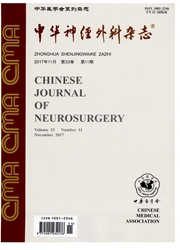

 中文摘要:
中文摘要:
目的 观察亚低温对脑缺血再灌注后神经细胞凋亡的影响.方法 制作SD大鼠脑缺血再灌注损伤模型,分亚低温治疗组和对照组,组织原位凋亡检测法检测亚低温治疗期间第24、48、72小时,以及复温后第24、48、72、96和120小时的细胞凋亡情况,RT-PCR方法检测所有观察时间点促凋亡基因Caspase、Fas和凋亡抑制基因Bcl-2的mRNA表达水平.结果 亚低温治疗组脑组织的细胞凋亡数量在亚低温治疗期间的三个检测时间点均少于对照组(P<0.05),复温以后逐渐增加,至复温后第72小时及以后细胞凋亡数量与对照组差异无统计学意义(P>0.05) 促凋亡基因Caspase、Fas和凋亡抑制基因Bcl-2的mRNA表达水平在亚低温治疗期间均低于对照组(P<o.05),复温后出现mRNA表达的同向性升高,复温72 h及以后接近对照组(P>0.05).结论 亚低温可明显减缓脑缺血再灌注后神经细胞的凋亡进程,但在其复温后凋亡速度迅速回升.因此,应积极争取亚低温治疗时间窗,同步进行神经细胞救治.
 英文摘要:
英文摘要:
Objective To observe the treatment effect of mild hypothermia on cerebral ischemiareperfusion nerve cell apoptosis, and study its mechanism from the molecular level. Methods SD rats were employed to produce cerebral ischemia-reperfusion injury model, then were divided into mild-hypothermia treatment group and control group. The cell apoptosis was detected by TUNEL mothod, during the mild hypothermia 24 h, 48 h, 72 h, and 24 h, 48 h, 72 h, 96 h and 120 h after rewarming, and RT-PCR method was used to detect the mRNA expression apoptosis gene Caspase-3, Fas and Bcl-2 at all the above time points. Results The apoptosis cell number during mild hypothermia therapy in mild hypothermia group was less than the control group (P〈0. 05), then increased gradually after rewarming, till to 72 h there was no significant difference between two groups (P 〉 0. 05). And the mRNA expression level of Caspase-3, Fas and Bcl-2 during mild hypothermia therapy in mild hypothermia group were lower than the control group (P 〈 0. 05), and increased with rewarming, till to 72 h after rewarming there was no significant difference between two groups (P〉0.05). Conclusion Mild hypothermia can reduce the number of nerve cell apoptosis in the process of cerebral ischemia and reperfusion, but the apoptosis rate rise rapidly with rewarming, it suggests that nerve cells will be rescued as soon as possible during mild hypothermia.
 同期刊论文项目
同期刊论文项目
 同项目期刊论文
同项目期刊论文
 期刊信息
期刊信息
